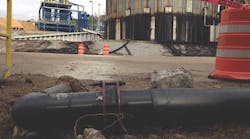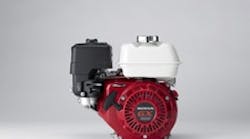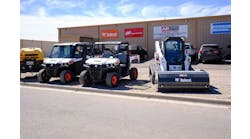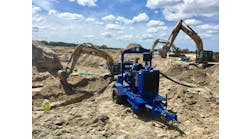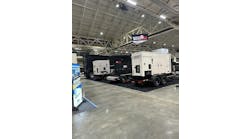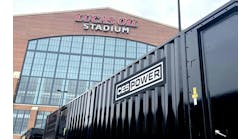When fires occur, especially in biomass energy facilities, responding quickly is crucial to keeping workers safe and minimizing damage to the facility. That’s why plant managers rely on a range of equipment to minimize the risk of fires, from spark detection technology to fire suppression systems. And, since fires occur even with the best systems in place, having a backup plan is essential.
For one Alabama biomass pellet mill, this story is a familiar one. Each year, the mill processes forest products into as much as 303,000 tons of wood pellets for use in power plants as a renewable energy source. Before processing the woodchips, the mill stores them in its two 150-foot silos — but it’s not something they can fill and forget.
Burning up
As the woodchips sit in silos, they begin to naturally decompose and generate heat energy. The heat creates hotspots that can lead to spontaneous combustion. In January, a hotspot caused one silo’s woodchips to catch fire inside. With smoldering woodchips inside the one silo the plant needed to act quickly to get the fire put out before it started heating the woodchips in the other nearby silo.
The plant’s permanent fire suppression system controlled the fire, but because it was using a generous amount of resources, it put the rest of the plant at risk if another fire occurred. The mill needed a backup system. The facility manager reached out to Tripp Brown, branch manager of United Pump Rentals Solutions, in Mobile, Alabama, asking for a solution.
United Rentals Pump Solutions is a specialty division of United Rentals, one of the largest equipment rental companies in the world. Brown rents and sells temporary pump solutions to customers in Alabama who need pumps for projects in the municipal, construction, industrial, mining and oil and gas markets. He and his team know that tight deadlines are common in the pump industry and, for many projects time is of the essence to minimize costly damage and ensure safety of everyone involved. And when customers feel the hot breath of fire start to burn up and damage productivity, finding the right solution quickly is imperative.
With a deadline of only two days to bring in equipment and have it ready to start fighting the fire in the plant’s silos, Brown needed a simple-to-set-up, cost effective and environmentally friendly pump solution, and he needed it fast.
Picking the pump
Brown had to take into account a few considerations before choosing a pump, one of which was the environment — especially since the river and riverbank area is environmentally protected. Because of this, a hydraulic leak or fuel spill from a diesel-driven hydraulic pump could cause damage and risk the integrity of the habitat and wildlife as well as possibly contaminate the water supply. That scenario would impose heavy costs for remediation and hefty fines.
“Because the area was environmentally sensitive we couldn’t use a diesel or hydraulic powered pump for risk of contamination if a spill occurred, so we knew we needed an electric pump,” Brown said.
Brown reached out to Atlas Copco for help finding the right pump. The plan was to run water from the nearby river through the pump and to a holding tank at the base of the burning silo. The water would then flow through another pump and into the silo to dowse the fire, cooling the hotspots and saturating unburned wood to prevent future hotspots from forming. That way the plant could remove and dispose of the damaged unusable chips safely.
“We helped Tripp choose the right submersible pump for the application based on the environmental concerns, required flow, elevation and distance from the river,” said Joe Moser, Atlas Copco Portable Energy product manager. “Looking at the situation, their best option was the WEDA 90 electric submersible pump.”
The WEDA 90 offered the power needed to handle the discharge head from the river and transfer the water up the 70 feet of hose from the river to the silo; a standard centrifugal pump didn’t have the suction lift capacity to meet the requirements of the project.
The team also had to consider the pump weight. The crane needed to suspend, support and lower the pump into the river with custom 50-foot slings and couldn’t handle anything weighing more than 600 pounds. Fortunately, Atlas Copco’s WEDA 90 is compact and weighs about 400 pounds, easily fitting within the crane’s limitations.
After working together to determine the right pump, Atlas Copco shipped the WEDA 90 pump directly to Brown in one day.
“This was the first time we used Atlas Copco pumps to meet one of our customer’s needs,” Brown said. “We chose Atlas Copco because they are known for high quality pumps and have a wide breadth of products to choose from. It was especially important that they were able to quickly get us the pump we needed.”
A simple set up
Brown and one other United Rentals Pump Solutions member set up the WEDA 90 in about an hour. Brown said the fast and easy setup was another benefit of using an electric pump over hydraulic. Had it been a hydraulic pump, setup could have taken as long as three hours to secure the hydraulic lines and prevent them from ripping or tearing.
The team hardwired the pump to the nearby permanent electrical power source and began pumping. The WEDA 90 moved water from the river into a frac tank for temporary water storage at the base of the silo. From the tank, Brown used a diesel pump to control the flow and pump water into a manifold that split the upper column into three separate lines at different stages of the silo for uniform water dispersal.
The WEDA pump ran 24/7 for three months, pushing 550 gallons per minute at more than 100 feet total dynamic head. After the water extinguished and saturated the smoldering wood chips, the plant was able to safely extract and dispose of the damaged chips.
“For this job, the submersible pump was the simplest, most cost effective and environmentally friendly option,” Brown said. “It worked so well that the energy plant that originally rented the pump purchased the system for permanent backup fire suppression.”
Resourceful results
Besides the environmental benefits, the WEDA 90 provided the plant with a less expensive option than a diesel model.
“The WEDA 90’s power consumption cost us $2,268 per month in kilowatt-hours. If we had used a diesel hydraulic submersible pump, the monthly fuel consumption would equal about $4,240,” Brown said.
Because the project was planned for six months, Brown saw a projected cost savings of $11,832 over the project duration by using an electric pump rather than a hydraulic model. To purchase a new WEDA 90 costs almost $18,000 less than buying a submersible package with hydraulic lines, and that’s not including about $370 spent monthly on maintenance.
“Both the rental price and operating expenses of using the electric submersible pump were cost effective,” Brown said. “The WEDA 90 lowered operating costs since it was virtually maintenance free, needing no hydraulic oil changes or filter replacements. And, most importantly, we saved on paying fuel costs with lower electric costs.”
Putting out the fire
When a fire emergency happens, innovative thinking and the right fire suppression systems are a must. Having a plan A and a plan B can keep chaos from occurring, minimize damage and increase worker safety. It’s also important to not only have enough resources, but the right resources, available. Part of any solution also comes through strong partnerships. When a rental center and manufacturer work together closely and quickly to find the best solution, it’s guaranteed the customer won’t get burned.
Michael Sagermann is business line manager, Portable Energy Division, Atlas Copco Construction Equipment
